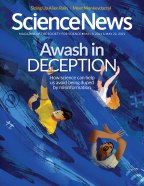Readers react to birds colliding with wind turbines, mysterious muons and more
- More than 2 years ago
When birds collide
Citizen science and bird migration data could help prevent birds from colliding with wind turbines, Jack J. Lee reported in “How to keep birds safe as U.S. wind farms expand” (SN: 5/8/21 & 5/22/21, p. 4).
Reader N. Adler noted that the story mainly discussed large birds such as eagles and whooping cranes. “Are smaller birds also in danger from being killed by the turbines?” Adler asked.
Smaller birds are affected too, Lee says. In fact, a 2014 study in PLOS ONE estimated that songbirds make up about 60 percent of wind turbine–related bird fatalities in the United States and Canada. “This may be because songbirds are one of the most abundant bird groups in these countries,” Lee says. “Raptors, a group of birds that includes eagles, seem to be particularly vulnerable to wind turbine collisions because of their flight behaviors, and their populations can be more at risk of decline due to low reproductive rates.”
Mask up
A microscopic look at the particle-filtering properties of different fabrics reveals the unseen, textured world of face masks, Emiliano Rodríguez Mega reported in “Texture matters for face mask protection” (SN: 5/8/21 & 5/22/21, p. 5).
Reader Tim Baldwin wanted to know how the size of the spaces between face mask fibers compares with that of the coronavirus that causes COVID-19.
Each coronavirus particle is about 100 nanometers across, molecular biology and senior writer Tina Hesman Saey says. Some scientists say an aerosol droplet must be at least 4.7 micrometers across to hold enough virus to be infectious. While there may be gaps between the fibers of cloth face masks larger than the droplets, a couple layers of material make it unlikely that those gaps will line up to let the droplets through, Saey says.
Smashing science
Scientists in the lab observed a mysterious magnetic property of subatomic particles called muons that could upend the standard model of particle physics, Emily Conover reported in “Muons may signal new physics” (SN: 5/8/21 & 5/22/21, p. 6).
Reader Jorge Ramos wondered if muons exist in atoms in nature or if the particles are made only in the lab.
“Muons don’t normally exist inside atoms,” Conover says, “but they are present on Earth naturally.” The particles form when cosmic rays from space crash into Earth’s atmosphere, producing a shower of muons. Physicists can create muons artificially by smashing protons into a target material, she says. “This way the scientists can generate a beam of muons that they can study, instead of a diffuse shower.”
Less is more
People default to addition when solving puzzles and problems, even when subtraction makes more sense, Sujata Gupta reported in “Subtraction does not come naturally” (SN: 5/8/21 & 5/22/21, p. 8).
Reader Robert Cox, a tutor, and some of his students noticed that the study participants were based in the United States and wondered if this preference for addition applies to other cultures.
The researchers did a preliminary study among university students in Japan and Germany, Gupta says. That study’s findings suggest that the tendency to add rather than subtract may be widespread. But more work is needed to understand why people default to addition, including how cultural factors such as social norms, industrialization and aesthetic preferences might influence that tendency, the researchers say.
Roaring good rhyme
Contagious yawns may help lions synchronize their movements, Jake Buehler reported in “Yawning lions move in sync” (SN: 5/8/21 & 5/22/21, p. 12). On Twitter, reader @starrylamp shared an inspired rhyme: “Yawning in public / Is simply outrageous / Cuz everyone knows / That yawning’s contagious!”

